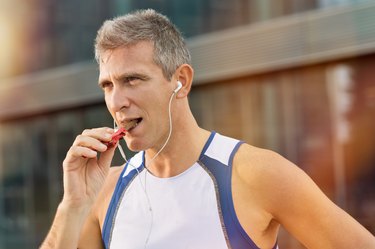
Everyone is looking for a faster road to meet their fitness goals, and brands are meeting the demand with products that promise easy solutions. And, recently, oxygenated water has been making a splash.
Some companies claim their oxygenated water is more effective at helping you recover after a sweat session than good ol' H2O. But we tapped the experts to weigh in on this trend and demystify whether this fancy water is really any better than tap.
Video of the Day
Video of the Day
First Off, What Is Oxygenated Water?
As advertised, oxygenated water is exactly what it sounds like: agua with extra oxygen infused into it. The idea behind oxygenated water is that providing more oxygen to the body could potentially improve athletic performance and recovery, Kelli McGrane, RD for Lose It!, says. There are even some brands that claim extra O2 could help us concentrate better, too.
To really understand what this looks like from a scientific perspective, it's important to remember the basic molecular structure of water: two hydrogen atoms for every oxygen atom, dietitian Kylene Bogden, RD, explains.
Following this logic, oxygenated water has more oxygen atoms, thus throwing that 2:1 ratio out the window. "Oxygenated water proponents state that having more oxygen in the blood and body can improve energy and metabolism and neutralize acid in the bloodstream [since water has a neutral pH), which thereby helps improve post-workout recovery," Bogden says.
Is It Really Better Than Regular Water?
There are some truths about oxygen and exercise, according to board-certified cardiologist and weight loss and nutrition expert, Luiza Petre, MD. However, oxygenated water can't exactly deliver on those perks.
Breathing during exercise (or panting, in some cases) is an important way to maintain our stamina, calm our racing heart and increase our performance — but there's a cap to it.
As Dr. Petre explains, we can only take in 5 to 10 percent of oxygen due to a biological limit of absorption. At a baseline, a healthy person has 97 to 99 percent oxygen bound to hemoglobin just from breathing air, and that level stays constant, even during an intense workout, she says.
So when our body needs more, it doesn't turn to bottled water. Rather, it just figures it out on its own: "Our body taps into anaerobic metabolism and the end product is lactate," Dr. Petre explains. Anaerobic metabolism occurs when our bodies burn carbs for energy when oxygen isn't readily available; the lack of oxygen in the bloodstream causes lactate build-up, which leads to muscle fatigue.
As we become stronger and build endurance, our body turns to aerobic metabolism because we become more efficient at using oxygen (and therefore don't feel as beat or sore). "The more trained you are, the longer you maintain aerobic metabolism," Dr. Petre says.
"A bottle of oxygenated water would have less oxygen than the amount you get taking a single breath."
With this information alone, it's pretty clear that our body doesn't need oxygenated water to do its thing — even if oxygenated water manufacturers claim the water is infused with "seven times more oxygen" than regular water, Melissa Nieves, RD, MPH, says. In fact, Berkeley University of California released a statement that puts it best: "A bottle of oxygenated water would have less oxygen than the amount you get taking a single breath."
Absorption also plays a part here, Nieves says, since oxygen is absorbed into the bloodstream through the lungs — and not through our gastrointestinal tract. In fact, researchers have even tested the theory, ultimately finding no association. One November 2001 study published in the European Journal of Medical Research found that while the GI tract does have the potential to absorb oxygen via the hepatic portal vein, it's only been tested on rabbits.
What's more, in a small study, researchers divided 20 men into two groups: Ten of them drank highly oxygenated water during a cycling workout while the other group of 10 drank regular water. Then, after a wash-out period, the two groups switched and the camp that drank regular water swapped it for oxygenated water.
The findings concluded that oxygenated water does not enhance aerobic performance or affect lactate clearance, according to the 2006 study in the International Journal of Sports Medicine.
"It's thought that an increase in oxygen saturation in the liver helps the organ metabolize — and thus eliminate — lactate better, but, so far, we don't have enough evidence to support this," she adds.
Better Ways to Recover After a Workout

Since oxygenated water isn't all it's chalked up to be, you can find more effective recovery methods in your kitchen. In addition to, well, breathing and drinking water the old-fashioned way, experts also recommend trying the following.
Coconut water: With a shorter workout, water will do just fine to help your muscles heal. However, if you do a super-intense fitness session for more than an hour — like a half-marathon or more — you might need to replenish with electrolytes. The same is true for summer-time workouts, since we tend to sweat more. Rather than reaching for a sugar-filled sports drink, McGrane suggests coconut water, a natural source of those necessary electrolytes.
Electrolyte boosters: Sometimes, water can become boring and monotonous, especially if you're gradually drinking more. To make it a tad more interesting, Boogden recommends mixing some electrolyte boosters to your water bottle or smoothies. Try Nuun Hydration electrolyte tablets ($24.00 per 40 servings on Amazon.com) or Cure Hydration Mix ($20.00 per bag on Amazon.com).
Snacks with protein and carbs: For when you're hangry after a bootcamp, boxing class or other activity, go for a high-protein snack that also includes healthy carbs to help rebuild muscle and promote recovery. Options include apple slices with peanut butter or a protein shake with whole fruit. You could also reach for one of these best protein bars.